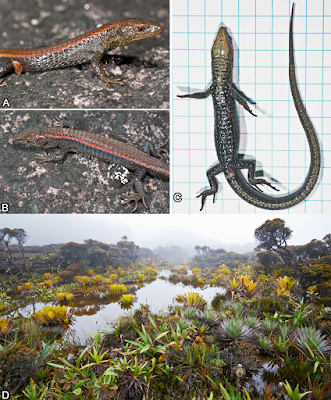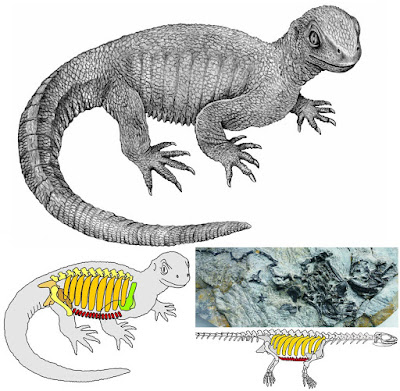![]() |
FIGURE 5. The six known species of the Goniurosaurus luii species group from China. A: a female individual of G. kwangsiensis sp. nov. from Guangxi; B: paratype KFBG 140334 of G. kadoorieorum sp. nov. from Guangxi; C: adult female of G. araneus from Guangxi; D: subadult male of G. bawanglingensis from Hainan; E: adult female of G. luii from Guangxi; F: holotype SYS r000218 of G. liboensis from Guizhou.
|
Abstract
Two new species of large geckos in the genus Goniurosaurus are described based on specimens collected from karst areas of Guangxi Zhuang Autonomous Region, southern China: Goniurosaurus kadoorieorum sp. nov. and Goniurosaurus kwangsiensis sp. nov. Data on natural history of the new species are provided, as well as discussions on the current conservation status of Goniurosaurus species in southern China. Due to the popularity of this genus as novelty pets, and recurring cases of scientific descriptions driving herpetofauna to near-extinction by commercial collectors, we do not disclose the collecting localities of these restricted-range species in this publication. However, such information has been presented to relevant government agencies, and is available upon request by fellow scientists.
Keywords: Eublepharidae, Goniurosaurus, new species, taxonomy, Guangxi, Southern China
Goniurosaurus kadoorieorum sp. nov.
Figs. 1–2, 5
Holotype. KFBG 14032, adult male, from Guangxi Zhuang Autonomous Region, China; exact locality withheld; available to qualified researchers upon request. Collected on 18 May 2014 by J.H. Yang.
Paratypes. Four paratypes: one adult male KFBG 14031; one adult female KFBG 14033; one sub-adult male KFBG 14034; one juvenile male KFBG 14035; data identical to the holotype. Coordinates and other standard collecting information were recorded for each type and kept in the KFBG herpetological collection catalog.
Etymology. The new species, “kadoorieorum”, is named in honour of the Kadoorie brothers, Sir Horace and Lord Lawrence, from Hong Kong, for their life-long support to biodiversity research and conservation in the region. As a common name we suggest “Kadoories’ Cave Gecko”.
Natural history and distribution.Goniurosaurus kadoorieorum sp. nov. is currently only known from its type locality in Guangxi Zhuang Autonomous Region in southern China. The new species appears to be a nocturnal karst specialist; all individuals were found amongst limestone rocks in karst forest at night.
Goniurosaurus kwangsiensis sp. nov.
Figs. 3–5
Holotype. KFBG 14052, adult male, from Guangxi Zhuang Autonomous Region, China; exact locality withheld; available to qualified researchers upon request. Collected on 5 July 2013 by J.H. Yang.
Paratypes. Three paratypes: two adult females KFBG 14050–51; one adult male KFBG 14053; data identical to the holotype. Coordinates and other standard collecting information were recorded for each type and kept in the KFBG herpetological collection catalog.
Etymology. The specific epithet “kwangsiensis” is named after its type locality, Guangxi Zhuang Autonomous Region, China (Kwangsi is the former official name of Guangxi). For the common name, we suggest “Guangxi Cave Gecko”.
Natural history and distribution. Specimens of the new species were found in karst forest at night. A total of nine individuals were found including four adult females, four adult males and one sub-adult; four were collected and assigned as the type series. A gravid adult female containing three well-developed eggs was among the nine seen but not collected. Three eggshells, most likely of G.kwangsiensis sp. nov., were also found in a rock crevice. Sympatric herpetofauna recorded in the locality during the survey included Asian Common Toad Duttaphrynus melanostictus (Schneider), King Cobra Ophiophagus Hannah (Cantor), and White-spotted Slug Snake Pareas
margaricophorus (Jan).
![]() |
FIGURE 5. The six known species of the Goniurosaurus luii species group from China. A: a female individual of G. kwangsiensis sp. nov. from Guangxi; B: paratype KFBG 140334 of G. kadoorieorum sp. nov. from Guangxi; C: adult female of G. araneus from Guangxi; D: subadult male of G. bawanglingensis from Hainan; E: adult female of G. luii from Guangxi; F: holotype SYS r000218 of G. liboensis from Guizhou.
|
Yang, Jian-huan & Bosco-Puilok Chan. 2015. Two New Species of the Genus
Goniurosaurus (Squamata: Sauria: Eublepharidae) from southern China.
Zootaxa.3980(1): 67–80.


































































